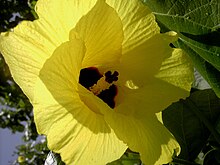Talipariti
Appearance
| Talipariti | |
|---|---|

| |
| Talipariti tiliaceum | |
| Scientific classification | |
| Kingdom: | Plantae |
| Clade: | Tracheophytes |
| Clade: | Angiosperms |
| Clade: | Eudicots |
| Clade: | Rosids |
| Order: | Malvales |
| Family: | Malvaceae |
| Subfamily: | Malvoideae |
| Tribe: | Hibisceae |
| Genus: | Talipariti Fryxell[1] |
| Species | |
|
About 22, see text | |
Talipariti is a genus of plants in the mallow family Malvaceae. It consists of 22 species, which are exclusively tropical except for one species whose range extends into temperate areas of Japan and Korea. Some authors treat these species as part of the genus Hibiscus, in which case they form the section Hibiscus sect. Azanza.[2]
Species
A partial list of species is:
- T. bowersiae[2]
- T. elatum (Hibiscus elatus)[3] - Native to Cuba and Jamaica but naturalized elsewhere.[3]
- T. glabrum (Hibiscus glaber)[3] - Bonin Islands in the northwest Pacific Ocean.[4]
- T. hamabo (Hibiscus hamabo) - Japan and Korea[3]
- T. hastatum (=Hibiscus hastatus)[3] - native to the Society Islands in the South Pacific, and cultivated elsewhere
- T. macrophyllum (=Hibiscus macrophyllus) - various areas of South Asia and Southeast Asia[3]
- T. tiliaceum (=Hibiscus tiliaceus) - native to many areas around the world[3][4]
References
- ^ "genus Talipariti". Germplasm Resources Information Network (GRIN) online database. Retrieved 16 April 2017.
- ^ a b Fryxell, Paul A. (2001), "Talipariti (Malvaceae), a segregate from Hibiscus", Contributions from the University of Michigan Herbarium, 23: 225–270
- ^ a b c d e f g Species Records of Talipariti, United States Department of Agriculture Germplasm Resources Information Network
- ^ a b Takayama, K; Ohi-Toma, T; Kudoh, H; Kato, H (Apr 2005), "Origin and diversification of Hibiscus glaber, species endemic to the oceanic Bonin Islands, revealed by chloroplast DNA polymorphism.", Molecular Ecology, 14 (4): 1059–71, doi:10.1111/j.1365-294X.2005.02462.x, ISSN 0962-1083, PMID 15773936
